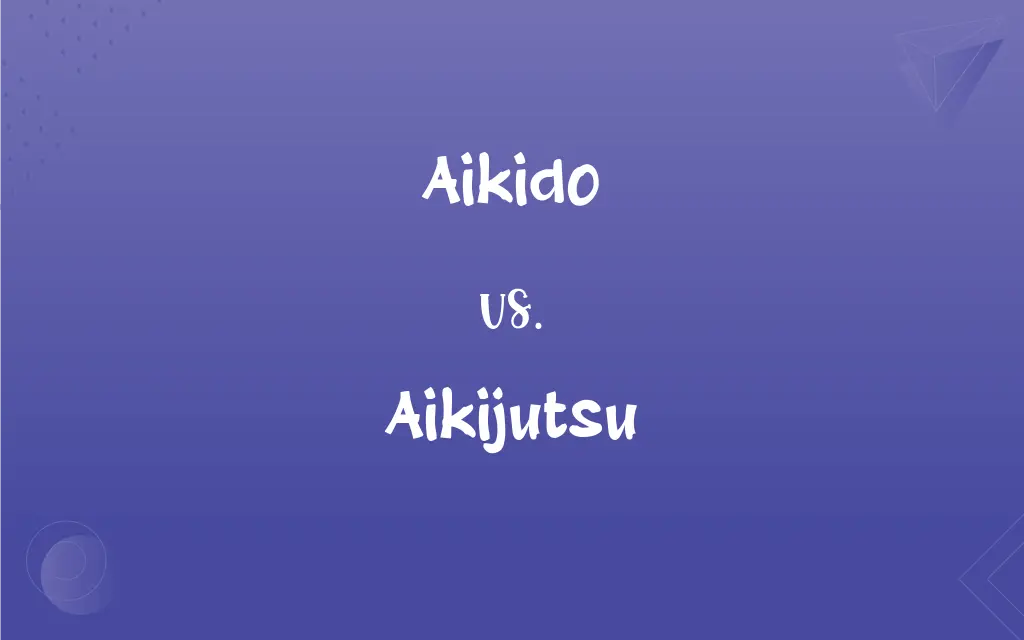Aikido vs. Aikijutsu: What's the Difference?
Edited by Aimie Carlson || By Janet White || Published on February 18, 2024
Aikido is a modern Japanese martial art focusing on harmony and defense, while Aikijutsu is an older form emphasizing joint locks and throws.

Key Differences
Aikido, a relatively modern martial art, emphasizes fluid motion and the redirection of an attacker's energy, often seen as a way to promote peace and harmony. Aikijutsu, on the other hand, is a more ancient martial art that focuses on quick and effective joint locks and throws, originally developed for samurai combat.
The philosophy of Aikido involves avoiding harm to the attacker, incorporating spiritual and philosophical elements, and is often seen as a path to self-improvement and harmony. Aikijutsu, in contrast, is more combat-oriented, with techniques designed for practical and efficient neutralization of threats, reflecting its samurai battlefield origins.
Training in Aikido often includes weapons training as a means to better understand movement and distance, but non-aggression remains a core tenet. Aikijutsu training, however, is more comprehensive in terms of combat, including strikes, grappling, and weapons, reflecting its practical combat application.
Aikido techniques are generally softer and more circular, aiming to blend with an attacker’s force. Aikijutsu techniques are typically more direct and forceful, employing hard strikes and firm joint locks, emphasizing practical defense.
Aikido, founded by Morihei Ueshiba in the 20th century, has evolved into various styles but retains its philosophical core. Aikijutsu, with a history predating Aikido, has its roots in the martial traditions of the Japanese warrior class and has influenced many modern martial arts, including Aikido.
ADVERTISEMENT
Comparison Chart
Origin
20th century, Japan
Ancient Japan, samurai era
Philosophy
Harmony, non-aggression, self-improvement
Practical combat, efficiency, battlefield tactics
Techniques
Circular, blending with attacker’s force
Direct, forceful, includes strikes and joint locks
Training Focus
Defense, spiritual growth, avoiding harm
Combat effectiveness, diverse combat skills
Weapons Training
Supplementary, for understanding movement
Integral, for practical combat application
ADVERTISEMENT
Aikido and Aikijutsu Definitions
Aikido
Aikido is a Japanese martial art focused on harmonizing with an opponent.
In aikido, practitioners redirect the energy of attacks rather than confronting them head-on.
Aikijutsu
Aikijutsu includes a wide range of combat techniques.
Aikijutsu training covers everything from grappling to weapon defense.
Aikido
Aikido techniques include throws and joint locks.
He skillfully used an aikido throw to neutralize the attacker without causing harm.
Aikijutsu
Aikijutsu emphasizes quick, decisive movements.
In aikijutsu, speed and efficiency are key to overpowering an opponent.
Aikido
Aikido integrates physical techniques with philosophical teachings.
Aikido training not only improved his physical fitness but also his mental well-being.
Aikijutsu
Aikijutsu is a traditional Japanese martial art focusing on joint manipulation.
The aikijutsu master demonstrated how to effectively control an opponent with precise joint locks.
Aikido
Aikido emphasizes non-violent conflict resolution.
She used aikido principles to de-escalate a heated argument peacefully.
Aikijutsu
Aikijutsu originated from the martial practices of the samurai.
Aikijutsu techniques reflect the practical and versatile fighting style of ancient samurai warriors.
Aikido
Aikido is known for its fluid and dynamic movements.
The aikido demonstration showcased the beauty of fluid motion in self-defense.
Aikijutsu
Aikijutsu is known for its effectiveness in close combat.
He used aikijutsu to defend himself in a close-range encounter.
Aikido
A Japanese art of self-defense that employs holds and locks and that uses the principles of nonresistance in order to debilitate the strength of the opponent.
Aikido
(uncountable) A Japanese martial art developed from jujitsu and making use of holds and throws.
Aikido
(countable) A school of the martial art.
Aikido
A Japanese martial art employing principles similar to judo
FAQs
How do Aikido and Aikijutsu differ in philosophy?
Aikido emphasizes harmony and non-violence, while Aikijutsu focuses on practical combat efficiency.
Are weapons a part of Aikijutsu?
Yes, Aikijutsu includes comprehensive training with various weapons for combat readiness.
What is Aikijutsu?
Aikijutsu is an ancient Japanese martial art emphasizing joint locks and quick, effective combat techniques.
What is Aikido?
Aikido is a modern Japanese martial art focusing on harmony and non-aggressive self-defense.
What are the physical benefits of practicing Aikido?
Aikido improves balance, coordination, flexibility, and overall physical fitness.
Can Aikido be used in competitive sports?
Aikido is generally non-competitive, focusing more on personal and spiritual development.
Are strikes and kicks a part of Aikijutsu?
Yes, Aikijutsu includes strikes and kicks as part of its comprehensive combat techniques.
Are weapons used in Aikido training?
Yes, weapons like wooden swords and staffs are used in Aikido for understanding movement and distance.
Does Aikido involve strikes and kicks?
Aikido primarily uses throws and joint locks, with minimal emphasis on strikes.
Is Aikijutsu effective against multiple attackers?
Aikijutsu's quick and decisive techniques can be adapted to handle multiple assailants.
What is the mental or spiritual aspect of Aikido?
Aikido promotes mental clarity, inner peace, and spiritual growth through its practices.
How long does it take to become proficient in Aikido?
Proficiency in Aikido can vary, typically taking several years of dedicated practice.
Is Aikido suitable for self-defense?
Aikido offers effective self-defense techniques, focusing on avoiding harm to the attacker.
Is Aikijutsu practical for modern self-defense?
Aikijutsu's efficient and versatile techniques are practical for various self-defense situations.
Does Aikijutsu have competitive aspects?
Traditionally, Aikijutsu is not competitive, but some modern schools may incorporate sparring.
How does Aikido handle multiple attackers?
Aikido techniques are designed to effectively manage and neutralize multiple attackers.
What are the physical benefits of practicing Aikijutsu?
Aikijutsu enhances strength, agility, reflexes, and practical combat skills.
How long does it take to master Aikijutsu?
Mastery of Aikijutsu also varies, often requiring many years of rigorous training.
Can children learn Aikido or Aikijutsu?
Both Aikido and Aikijutsu can be adapted for children, focusing on discipline and physical fitness.
Does Aikijutsu incorporate any spiritual elements?
While primarily combat-focused, some Aikijutsu schools may include spiritual or ethical teachings.
About Author
Written by
Janet WhiteJanet White has been an esteemed writer and blogger for Difference Wiki. Holding a Master's degree in Science and Medical Journalism from the prestigious Boston University, she has consistently demonstrated her expertise and passion for her field. When she's not immersed in her work, Janet relishes her time exercising, delving into a good book, and cherishing moments with friends and family.
Edited by
Aimie CarlsonAimie Carlson, holding a master's degree in English literature, is a fervent English language enthusiast. She lends her writing talents to Difference Wiki, a prominent website that specializes in comparisons, offering readers insightful analyses that both captivate and inform.
































































